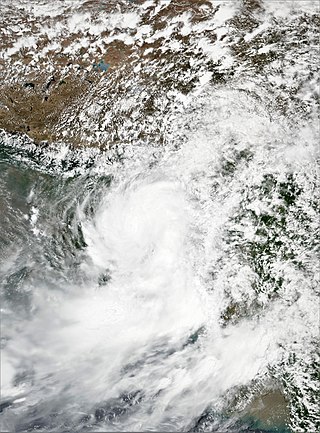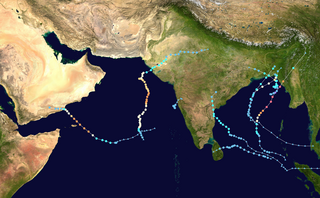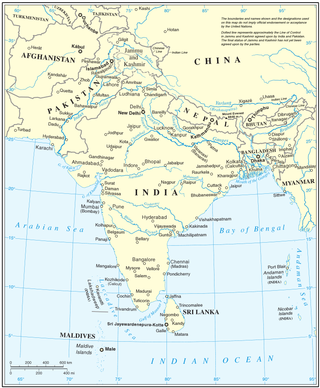
The 1992 North Indian Ocean cyclone season was unofficially the most active year on record for the basin, with 10 tropical storms developing, according to the Joint Typhoon Warning Center (JTWC). There are two main seas in the North Indian Ocean – the Bay of Bengal to the east of the Indian subcontinent – and the Arabian Sea to the west of India. The official Regional Specialized Meteorological Centre in this basin is the India Meteorological Department (IMD), while the JTWC releases unofficial advisories. An average of four to six storms form in the North Indian Ocean every season with peaks in May and November. Cyclones occurring between the meridians 45°E and 100°E are included in the season by the IMD.

The 2003 North Indian Ocean cyclone season was the last season that tropical cyclones were not publicly labeled by India Meteorological Department (IMD). It was the third consecutive below average season. Also was mostly focused in the Bay of Bengal, where six of the seven depressions developed. The remaining system was a tropical cyclone that developed in the Arabian Sea in November, which was also the only system that did not affect land. There were three cyclonic storms, which was below the average of 4–6. Only one storm formed before the start of the monsoon season in June, although it was also the most notable. On May 10, a depression formed in the central Bay of Bengal, and within a few days became a very severe cyclonic storm. After it stalled, it drew moisture from the southwest to produce severe flooding across Sri Lanka, killing 254 people and becoming the worst floods there since 1947. Damage on the island totaled $135 million (2003 USD). The storm eventually made landfall in Myanmar on May 19. It is possible that the storm contributed to a deadly heat wave in India due to shifting air currents.

The 1989 North Indian Ocean cyclone season was a below-average season in annual cycle of tropical cyclone formation. Despite this, the season had the second highest Accumulated Cyclone Energy in the basin on record behind only 2019 and 2023. The season has no official bounds but cyclones tend to form between April and December. These dates conventionally delimit the period of each year when most tropical cyclones form in the northern Indian Ocean. There are two main seas in the North Indian Ocean—the Bay of Bengal to the east of the Indian subcontinent and the Arabian Sea to the west of India. The official Regional Specialized Meteorological Centre in this basin is the India Meteorological Department (IMD), while the Joint Typhoon Warning Center (JTWC) releases unofficial advisories. An average of five tropical cyclones form in the North Indian Ocean every season with peaks in May and November. Cyclones occurring between the meridians 45°E and 100°E are included in the season by the IMD.

At least 29 tropical cyclones have affected Myanmar, a country adjacent to the Bay of Bengal in mainland Southeast Asia. Myanmar has witnessed some of the deadliest storms in the Bay of Bengal, including Cyclone Nargis in May 2008, which struck the low-lying Irrawaddy Delta near Yangon. Its winds and storm surge killed an estimated 140,000 people and left nearly $10 billion in damage. The country's worst natural disaster in the 20th century was a cyclone in 1968, which killed more than 1,000 people when it hit Rakhine State in northwestern Myanmar. One of the most powerful storms to ever hit the country was Cyclone Mocha, which it moved ashore northwestern Myanmar in May 2023, killing at least 413 people.

Cyclonic Storm Viyaru, operationally known as Cyclonic Storm Mahasen, was a relatively weak tropical cyclone that caused loss of life across six countries in Southern and Southeastern Asia. Originating from an area of low pressure over the southern Bay of Bengal in early May 2013, Viyaru slowly consolidated into a depression on May 10. The depression gained forward momentum and attained gale-force winds on May 11 and was designated as Cyclonic Storm Viyaru, the first named storm of the season. Owing to adverse atmospheric conditions, the depression struggled to maintain organized convection as it moved closer to eastern India. On May 14, the exposed circulation of Viyaru turned northeastward. The following day, conditions again allowed for the storm to intensify. Early on May 16, the cyclone attained its peak intensity with winds of 85 km/h (55 mph) and a barometric pressure of 990 mbar. Shortly thereafter Viyaru made landfall near Chittagong, Bangladesh. On May 17, it moved over the eastern Indian state of Nagaland.

Cyclonic Storm Roanu was a relatively weak tropical cyclone that caused severe flooding in Sri Lanka and Bangladesh during May 2016. It is the first tropical cyclone of the annual cyclone season. Roanu originated from a low-pressure area that formed south of Sri Lanka, which gradually drifted north and intensified into a cyclonic storm on 19 May. However, wind shear and land interaction caused it to weaken slightly, before reintensifying as it accelerated towards the coast of Bangladesh.

The 2017 North Indian Ocean cyclone season was a below average yet deadly season in the annual cycle of tropical cyclone formation. This season produced only three named storms, of which one only intensified into a very severe cyclonic storm. The North Indian Ocean cyclone season has no official bounds but cyclones tend to form between April and December with the two peaks in May and November. These dates conventionally delimit the period of each year when most tropical cyclones form in the northern Indian Ocean. The season began with the formation Cyclone Maarutha on April 15 and ended with the dissipation of a deep depression on December 9.
The 2017 Sri Lanka floods resulted from a heavy southwest monsoon, beginning around 18 to 19 May 2017. Flooding was worsened by the arrival of the precursor system to Cyclone Mora, causing flooding and landslides throughout Sri Lanka during the final week of May 2017. The floods affected 15 districts, killed at least 208 people and left a further 78 people missing. As of 3 June, 698,289 people were affected, while 11,056 houses were partially damaged and another 2,093 houses completely destroyed. According to Al Jazeera, about 600,000 people have been displaced due to the floods.

Severe Cyclonic Storm Mora was a moderate but deadly tropical cyclone that caused widespread devastation and severe flooding in Sri Lanka, Andaman and Nicobar Islands, Bangladesh, Myanmar and Northeast India in May 2017. The second named storm of the 2017 annual cyclone season, Mora developed from an area of low pressure over the southeastern Bay of Bengal on May 28. Mora reached peak strength with maximum sustained winds of 110 km/h (70 mph). The cyclone made landfall near Chittagong on the morning of May 30 and steadily weakened, dissipating early in the morning on May 31. Across its path, Mora dropped a large amount of rain, including 225mm of rainfall in Chittagong and northeast India. The storm is estimated to have caused damages nearing US$300 million.

On 12 June 2017, heavy monsoon rain triggered a series of landslides and floods in Rangamati, Chittagong and Bandarban - three hilly districts of Bangladesh - and killed at least 152 people. The weather also caused power cuts and telecommunications disruptions, making it difficult for rescuers to reach affected communities. Reaz Ahmed, head of Bangladesh's Disaster Management Department, said the landslides were the worst in the country's history.
In mid-March 2019, monsoonal downpours caused widespread flooding and landslides across South Asia.
The 2021 floods and landslides in Sri Lanka are flash floods and mudslides which were caused from heavy torrential rainfalls during May and June 2021. As of 7 June 2021; the monsoon floods affected in about 10 districts, killing at least 17 persons including about 10 because of floods and 4 people because of mudslides. About 245,000 people were affected living in Colombo, Puttalam, Kandy, Kalutara, Kurunegala, Gampaha, Nuwara Eliya, Ratnapura and Galle. More than 800 houses were reported to have been damaged.

The 2023 North Indian Ocean cyclone season was an above-average and deadly season, becoming the most active since 2019, with nine depressions and six cyclonic storms forming. It was the deadliest since 2017, mostly due to Cyclone Mocha, and had the second-highest accumulated cyclone energy (ACE) in the basin, after 2019. It also had the most extremely severe cyclonic storms on record, tying with 1999 and 2019. The North Indian Ocean cyclone season has no official bounds, but cyclones tend to form between April and December, with the peak from May to November. These dates conventionally delimit the period of each year when most tropical cyclones form in the northern Indian Ocean. However, a cyclone can form at any time during the year shown by an unnamed depression that affected Sri Lanka in January–February.

From January to October 2022, excessive rainfall and widespread monsoon flooding occurred in the South Asian countries of Afghanistan, Bangladesh, India, Nepal, Pakistan, and Sri Lanka. It has become the region's deadliest floods since 2020, with over 4,700 people dead.

In 2020, floods severely affected South Asia due to heavy monsoon rains. The floods caused $105 billion USD of damage, making them the costliest floods in modern history, and the ninth costliest disaster of all time. In addition there were 6,511 fatalities, the most reported in a flood since Cyclone Sidr in 2007. Floods continued in 2021 and 2022.

After over 6,500 people died in flooding in 2020, monsoon floods hit South Asia again in 2021.

The following is a list of weather events that occurred on Earth in the year 2023. The year saw a transition from La Niña to El Niño, with record high global average surface temperatures. The several weather events which had a significant impact were blizzards, cold waves, droughts, heat waves, wildfires, floods, tornadoes, and tropical cyclones.
From February to late-December 2023, floods killed over 2,600 people in 15 countries across Africa.

Extremely Severe Cyclonic Storm Mocha was a powerful and deadly tropical cyclone in the North Indian Ocean which affected Myanmar and parts of Bangladesh in May 2023. The second depression and the first cyclonic storm of the 2023 North Indian Ocean cyclone season, Mocha originated from a low-pressure area that was first noted by the India Meteorological Department (IMD) on 8 May. After consolidating into a depression, the storm tracked slowly north-northwestward over the Bay of Bengal, and reached extremely severe cyclonic storm intensity. After undergoing an eyewall replacement cycle, Mocha rapidly strengthened, peaking at Category 5-equivalent intensity on 14 May with winds of 270 km/h (165 mph). Mocha slightly weakened before making landfall, and its conditions quickly became unfavorable. Mocha rapidly weakened once inland and dissipated shortly thereafter.
The 2023 Pakistan floods occurred from March to July of 2023, caused by monsoon rains which returned to Pakistan after nine months after the 2022 Pakistan floods. Floods worsened at the end of June due to upcoming monsoon rains. At least 159 people were killed, including many children.














